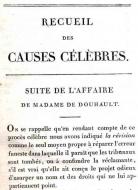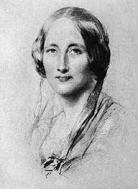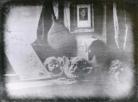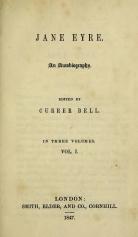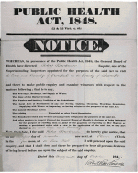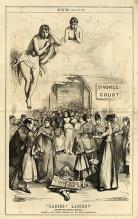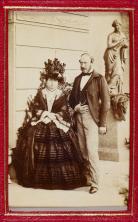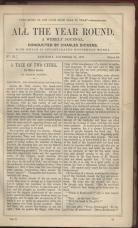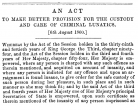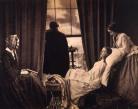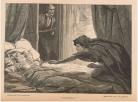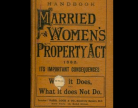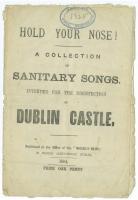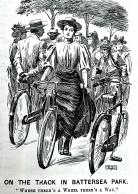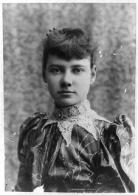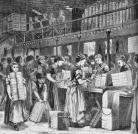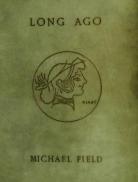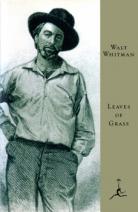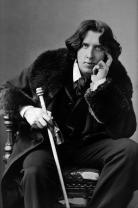ENGH/WGST 304 Timeline
Created by Wendy Kolmar on Tue, 01/16/2024 - 20:38
This timeine is a collaborative project of the Spring 2024 class. It will incorporate student-created entries related to the texts we are reading and provide contextual historical and cultural information for those texts.
Timeline
Chronological table
| Date | Event | Created by | Associated Places | |
|---|---|---|---|---|
| circa. 1770 |
The Founding of Mesmerism
In the 1770s, the theory of "animal magnetism" (or mesmerism) was established by the German physician Franz Anton Mesmer. Animal magnetism gained traction in the former half of the 19th century as the study developed and gained a greater foundation in science. In a time when numerous physiological questions were being raised, mesmerism offered an explanation and a solution to abnormal human psychology and behavior.
Mesmerism posited that there existed in living things a force, or a magnetic fluid, that could be harnessed by an operator and used either to heal or control an individual. The inherent metaphysical basis of mesmerism called into question its reliability as a science, and it was widely contested by the English medical community. Its pushback was magnified by its foreign origin. Studies of mesmerism were most widely practiced in France and Germany, so its presence in England magnified revolutionary anxieties. |
Keiran Dugan | ||
| circa. 1808 |
Recueil Des Causes Célèbres, written by Maurice Mejan, was publishedThe Woman in White is based on a true story; specifically, an actual case of a woman's wrongful imprisonment from Maurice Mejan's 1808 book: Recueil des Causes Celebres. Wilkie Collins was inspired by the idea of substituted identity and the misuse of lunatic asylums. The case, in particular, was about Marie Douhault who was locked away in a lunatic asylum. Marie's identity was stolen after she had been drugged and placed in an asylum under a flase name. Moroever, she was presumed dead and her estate was passed on to her heirs. It is important to acknolwedge the 1850s ‘lunacy panic’ within Victorian Society. In the 1850s, lurid rumours that medical doctors were declaring normal people "insane" in Britain, were spread by the press causing widespread public anxiety. The fear was that people who were a source of embarrassment to their families were conveniently disposed of into asylums with the willing connivance of the psychiatric profession. |
Brenna Hezel | ||
| 29 Autumn 1810 to 12 Nov 1865 |
Elizabeth GaskellElizabeth Gaskell is a writer worth knowing. Gaskell, born in 1810 was a friend of both Charles Dickens and Charlotte Bronte. She was employed by Dickens and she wrote "The Life of Charlotte Brontë" (1857) after Bronte's death. Along with the text Lizzy Leigh(1850), some of her famous works include "North and South"(1855)," Mary Barton" (1848),and "Cranford"(1853). She is also named as a trailblazer of female supernatural writers in “Monster, she wrote '' (2019). Though she is more known for her radical politics, especially in her views on industrialization, poverty, and the rights of women. In some of her work, we see a conscious and oftentimes sympathetic subversion of the fallen woman trope. The typical narrative regarding a fallen woman, is that an innocent woman is led astray and becomes a prostitute and dies alone. She is seen as tragic, but ultimately unredeemable. Gaskell goes against this, offering some repentance to these women such as in Lizzy Leigh(1850) where a mother actively attempts to recover her lost daughter. “Elizabeth Cleghorn Gaskell.” Encyclopædia Britannica, Encyclopædia Britannica, inc., 5 Mar. 2024, www.britannica.com/biography/Elizabeth-Cleghorn-Gaskell. The Gaskell Society, 5 aug, 2022 gaskellsociety.co.uk/.
|
Nicole Prill | ||
| 25 Dec 1831 to The start of the month Jan 1832 |
The Baptist WarThe Baptist War was an eleven-day uprising led by Samuel Sharpe and 60,000 enslaved Jamaicans. The revolt took place on December 25th, 1831, and was considered the largest slave rebellion in the British Caribbean. On Christmas Day the leaders of the uprising went on strike demanding more freedom and a working wage. They refused to work until their demands were met by the plantation owners. While the revolt was intended to be a peaceful strike, it escalated into a full rebellion when the planters refused their demands. Violence soon erupted in Kensington Estate with sugar cane fields and plantations being burnt to the ground. The rebellion ended in the first week of January 1832 by the force of colonial authorities. As a result of the rebellion, over 200 rebels had been killed and more than 300 hundred enslaved individuals were executed. The Baptist War played a major part in abolishing slavery throughout the British Empire in 1838. Momodu, Samuel. “The Baptist War (1831-1832).” Blackpast.org, 22 July 2017, www.blackpast.org/global-african-history/baptist-war-1831-1832/. Accessed 10 Feb. 2024. |
Janelle Campos | ||
| 19 Aug 1839 |
Creation of the DaguerreotypeInvented by Louis-Jacques-Mandé Daguerre in France during the 1830s, the daguerreotype holds historical significance as the first commercially successful method of photography. The invention was announced to the public on August 19, 1839, during a meeting of the French Academy of Sciences in Paris. With the arrival of the daguerreotype, Victorian England experienced a revolution in visual representation. This process relied on a polished silver plate coated with light-sensitive silver iodide. The plate was exposed to light within a camera, capturing an image. Subsequent treatment with mercury vapor and a salt solution fixed the image permanently. Daguerreotypes offered an unparalleled level of detail and lifelike representation, blurring the lines between art and science. The introduction of the daguerreotype sparked debate regarding its classification. While the process undoubtedly involved scientific principles of light and chemistry, the resulting images possessed undeniable artistic qualities. The detailed realism challenged traditional notions of artistic creation, raising questions about the role of the artist in replicating reality versus interpreting it. Despite lengthy exposure times and hazardous materials, daguerreotypes became highly sought after, particularly for portraiture. Studios specializing in daguerreotypes emerged in major cities, offering the public a chance to experience this process. Furthermore, owning a daguerreotype signified not only wealth but also a connection to a revolutionary technology. The daguerreotype forever altered the way people captured and viewed the world. Though eventually surpassed by other photographic techniques, the daguerreotype stands as a pivotal achievement. It created a new era of visual documentation, transforming the landscape of art and science. Sources: https://www.britannica.com/technology/photography/Photographys-early-evolution-c-1840-c-1900 https://www.metmuseum.org/toah/hd/dagu/hd_dagu.htm https://www.loc.gov/collections/daguerreotypes/articles-and-essays/the-daguerreotype-medium |
Janelle Campos | ||
| 1842 |
1842 General StrikeIn the summer of 1842, workers across Britain organized the first general strike within a capitalist country. The strike started in North Staffordshire, where coal miners stopped working to demand better wages. Word spread to other coal mining regions and in August, 800 coal miners gathered in Halifax, a town in West Yorkshire. This virtually stopped railways, mines, factories, and mills from functioning. Realizing the power they held by simply refusing to work, over half a million workers across the country then decided to stop working and demanded several things, two being better wages and the right to vote. This was a monumental moment in the 1840s, however like many suffrage movements of the time, women were not included. https://tribunemag.co.uk/2022/08/1842-general-strike-halifax-history-180... |
Madelyn Fama | ||
| 1847 |
Charlotte Bronte, Jane EyrePublished in 1847. |
Wendy Kolmar | ||
| 31 Aug 1848 |
The 1848 Public Health ActProposed by Edwin Chadwick in 1848, The Public Health Act was institutionalized in order to improve the health of commoners. This action was a response to their poor health standards and living conditions following a cholera outbreak in 1848. In Jane Eyre, Jane is sent to a boarding school where sickness runs rampant and the standard of living is less than ideal. Brontë writes, "Semi-starvation and neglected colds had predisposed most of the pupils to receive infection: forty-five out of the eighty girls lay ill at a time...Many, already smitten, went home only to die: some die at the school, and were buried quietly and quickly; the nature of the malady forbidding delay" (141). Following a typhus outbreak in the school, the school takes a turn for the better with the appointment of a new headmaster. The new authority cleans up the poor living conditions and the people of the time realize how important sanitation is for the common people to exist healthily and happily. The mistreatment of the less fortunate students at Lowood becomes a metaphor for the broader societal neglect of the disadvantaged. The conditions at the institution were used as a convenient representation of Brontë’s real society in which public health and social reform were only just beginning to be addressed by legislation like the Public Health Act of 1848. |
Dee Cohen | ||
| Oct 1853 to 30 Mar 1946 |
The Crimean WarThe Crimean War lasted from 1853-1856 bewteen Russia and the forces of Britain, France, and the Ottoman Empire. There were two main causes of the war: territorial expansion and religion. Czar Nicholas I (Czar of Russia) was attempting to expand his influence over the Middle East and the eastern Mediterranean at the expense of the declining Ottoman Empire. The British and French, in turn, saw Nicholas’ power grab as a danger to their trade routes. There was a great struggle for Jerusalem and other "sacred places" under Turkish rule between the Orthodox believers and Catholics. After Austria threatened to join the allies during the Crimean War, Russia accepted preliminary peace terms in 1856. The resulting Treaty of Paris, signed on March 30, 1856, guaranteed the integrity of Ottoman Turkey. There were an estimated 650,000 lives lost (many of them Birtish soldiers). Although Jane Eyre was published in 1847, it's possible that Charlotte Brontë was influenced by the socio-political atmosphere leading up to the conflict. In the years preceding the Crimean War, Britain was undergoing significant social and political transformations. The mid-19th century was marked by the rise of industrialization, urbanization, and the expansion of the British Empire. These changes brought about shifts in social hierarchies, economic structures, and cultural norms, leading to heightened tensions and debates over issues such as class inequality, women's rights, and colonialism. Jane Eryre reflects many of the concerns and values of the Victorian era, including the tension between social classes, the constraints imposed by gender roles, and the quest for individual autonomy and morality. Although "Jane Eyre" is set in a different historical context, its themes of injustice, oppression, and individual agency parallel the broader moral and existential dilemmas raised by the Crimean War. History and Britannica |
Dee Cohen | ||
| 1857 |
Elizabeth Barrett Browning, AURORA LEIGH. . . |
Wendy Kolmar | ||
| 1857 |
Coventry Patmore, The Angel in the HouseCoventry Patmore (1823-1896) |
Wendy Kolmar | ||
| 28 Aug 1857 |
The Matrimonial Causes Act of 1857Marriage and divorce had been fairly uncontested throughout history up until 1850 when Prime Minister Lord Russel established the Royal Commission on Marriage. This commission was meant to evaluate the state of marriage in the UK and the findings were used to create the Divorce Bill of 1854 and 1856. This bill was delayed and hotly contested by the Parliament- however, at this point, women's issues were beginning to reach a boiling point and by delaying it, the government inadvertently turned the bill into more of a feminist issue. The Matrimonial Causes Act of 1857 was pivotal in the history of marriage, as it both legalized and created a procedure for filing for divorce. Before this act, divorces were very complicated to achieve: they were very costly, often being more than £1,000; they could only be granted by a private act of parliament; and they were almost exclusively granted to men. This 1857 Act created a formal Court of Divorce and Matrimonial Causes, which established the grounds for divorce at the time- "men could divorce their wives, as before, on the basis of adultery alone; women, however, had to prove their husbands' adultery in addition cruelty, desertion, incest, rape, sodomy, or bestiality" (Kent, 29). The sexual double standard was enforced heavily through this law, legally enforcing that a woman's infidelity was inherently worse than a man's. Additionally, this act was supposed to extend the reach of the divorce court outside of London, but this was never put into place. However, it did offer some protections for divorced women- it acknowledged and protected her future earnings and property from her ex-spouse.
Hager, Kelly. “Chipping Away at Coverture: The Matrimonial Causes Act of 1857.” BRANCH: Britain, Representation and Nineteenth-Century History. Ed. Dino Franco Felluga. Extension of Romanticism and Victorianism on the Net. Web. 2/8/2024 |
Keys Newell | ||
| 26 Jul 1859 |
Frances Sally DayOn this day, Frances Sally Day became to first women to photograph the royal family, Queen Victoria at Osborne House. On this day Queen Victoria wrote 'Was photographed on the Lower Terrace by Miss Day, & together with Mama & the children'. No women had ever photographed the royal family especially the queen. Frances was a talented photographer which she learned from her father and as well as a talented artist who had 40 portraits accecpted into the Royal Academy exhibition from 1838-1858. Her achievements during this time was important in inspiring over Victorian women to do photography even as an art form. Since Frances began as an artist and a painter her photography was not only professional but artistic. |
Brooke Mercer | ||
| 26 Nov 1859 to 25 Aug 1860 |
Wilkie Collins, Woman in WhiteOriginally serialized between 26 November 1859 – 25 August 1860 in All the Year Round, conducted by Charles Dickens, |
Wendy Kolmar | ||
| 1860 to 1900 |
The Aesthetic MovementThe Aesthetic Movement in Britain (1860 – 1900) aimed to escape the Industrial Age by focusing on creating art that was beautiful rather than having a deeper meaning -- 'Art for Art's sake'. The movement itself was characterizied by its denoucing of morality and middle-class values. The influence of the Victorian Age was waning and being replaced by Aesthetic values partly because Britain’s political and economic supremacy faced new challenges in the form of emerging world powers. Simply, the "glory days" of Britain’s empire were coming to an end and resulted in an anti-Victorian method of thought. The movement's ending is often associated with Oscar Wilde's trial. The actual movement's figure was the dandy and associated with Wilde's, The Picture of Dorian Gray. According to the Broad View verison of Romance of a Shop, Amy Levy was inspired by aestheticism -- "The buttonhole flower was the chief accessory to the aesthetic's wardrobe, while 'languishing' became a quality that captured Fin de siècle [end of the century in French] ennui" (78). This painting, in particular, was created by John Atkinson Grimshaw (1836–1893) and called, The Rector's Garden, Queen of the Lilies 1877. Some other famous authors or painters and their famous works include Oscar Wilde (author of The Picture of Dorian Gray), Dante Gabriel Rossetti (painter of Proserpine), William Morris (more of a designer), and Algernon Charles Swinburne (known for his poems including Poems and Ballads (1866)). |
Brenna Hezel | ||
| 1860 |
Establishment of Florence Nightingale's Nursing SchoolIn 1860, Florence Nightingale was able to use government funds awarded to her after the Crimean War to establish the first secular nursing school. In doing so, Nightingale began to professionalize nursing and provide a sort of headquarters for training in the profession. She also brought more women into the field, which was made more socially acceptable by Nightingale's previous achievements. As a result of the school being opened, more nurses and midwives were able to assist in helping those of lower classes. Many alumna of the school would go on to open their own schools or bring about advancements in the field of nursing. Despite the positive actions taken by Nightingale, she was an extremely harmful figure in many other respects. She held outdated views on medical theory, which means that she likely influenced generations of nurses in a way that hurt the medical field. Additionally, her views on colonialism would have influenced the way she approached medical treatment of non-European people. For example, she saw Indigenous people as lesser than English people. She also contributed to the English imperial project. Altogether, the positive impact that Nightingale had with her nursing school is largely negated by all the harmful beliefs and practices she perpetuated. The school still exists in a form today; however, it is part of King's College London. Sources: Florence Nightingale: Her Impact On Nursing And Colonialism | NurseJournal.org British Journal of Nursing - The legacy of Florence Nightingale's educational reforms for nursing |
Patrick Walsh | ||
| The start of the month Summer 1860 |
Care of Criminal Lunatics ActThis act, passed on August 6, 1860, aimed to "make better provision for the custody and care of criminal lunatics" (British Medical Journal, p. 672). This act declared that Queen Victoria, referenced as "Her Majesty," could declare any asylum or place in England suitable to become an asylum for criminal lunatics, and that nothing in the act would "restrain or affect the Authority of Her Majesty" (673). It further stated that the Secretary of State could direct patients deemed criminal lunatics to an asylum, make rules on how to govern an asylum, and appoint a council and officers to supervise said asylums. Other aspects of this act included provisions for removing and discharging patients, punishment for attempting and/or succeeding to escape or rescue someone from an asylum, penalties for officers that mistreat patients, and for "Commissioners in Lunacy" (674), such as physicians or surgeons, to inspect the asylums and report the visit and any notable findings to a Secretary of State. “An Act To Make Better Provision For The Custody And Care Of Criminal Lunatics.” The British Medical Journal, vol. 2, no. 191, 1860, pp. 672–74. JSTOR, http://www.jstor.org/stable/25196340. Accessed 14 Feb. 2024.
|
Grace Gannon | ||
| 17 Spring 1861 |
Unification of ItalyDuring the 1850's there were many civil wars breaking out among the different parts of Italy. Cities like Venice and Milan threw uprisings against the signing of a peace tready between Italy and Austria, these cities then attempted to create their own governments, and started taking over the Italy that was known as the Kingdom of the Two Sicilies. Victor Emmanuel II was ruling over parliament in the North and eventually Count Camillo Benso di Cavour entered the cabinet and imposed laissez-faire economic policies, and started on international commercial treaties to cushion the economic blow of the unification of italy. These policies alarmed the conservatives which aided the rebels in the south. In 1852 Cavour became head of the cabinet and introduced ecclesiastical, judicial, and fiscal reforms. Cavour made an alliance with the west and sent an army to Crimea which did very well, and the North was invited to the Congress of Paris as one of the victors of the Crimean war. After this the war of 1857 occured in which Cavour secretly met with Napoelon III and it was agreed that French troops would prevent Austrian intervention in the battle between North and South, due to this favor Cavour had to give Savoy and Nice to France. After Cavour resigned in 1859, Giuseppe Garibaldi gathered 1000 voulenteers who all wore red and sailed to sicily and then took over the southern part of Italy to meet with the northern forces and unite into the Kingdom of Italy in 1861. |
Kurt Sunderland | ||
| 1864 to 1869 |
The Creation of the Contagious Diseases ActThis act was passed in 1864 in an attempt to regulate sexually transmitted diseases in the military, but in 1869 was expanded. It gave police the complete power to determine whether a woman was a prostitute, and any women suspected of prostitution were required by law to register with the police and undergo an invasive medical exam to determine whether they were suffering from any sexually transmitted diseases. If they refused the exam, women could be imprisoned for up to six months with hard labor. If a woman was found to have any form of sexually transmitted disease, she could also be imprisoned–this time in a lock-hospital (a hospital specifically created to treat venereal disease) until pronounced clean. The act did not enforce any examination of men, including male sex workers or men who solicited prostitutes. Hamilton, Margaret. “Opposition to the Contagious Diseases Acts, 1864-1886.” Albion: A Quarterly Journal Concerned with British Studies, vol. 10, no. 1, 1978, pp. 14–27. JSTOR, https://doi.org/10.2307/4048453. Accessed 24 Mar. 2024.
|
Skylar Tanski | ||
| 1865 |
"The Bride, The Bridegroom and Sad Love" - Simeon SolomonSimeon Solomon was a British artist who created in the style of classicism and aestheticism. The works he produced were queer in nature, often depicting portrayals of same-sex relationships. Since homosexuality was criminalized during the victorian period, Solomon found a safe space for expression in his art. In his drawing from 1865 titled "The Bridge, The Bridgegroom and Sad Love," there is a representation of the forbidden nature of queer relationships during this time. There are 3 people in the drawing: a bridge, a groom, and an additional man. While the bride and groom appear to love in unison, there is a man who is holding hands with the group, symbolizing the presence of a concealed same-sex desire. This drawing reveals much about the experiences lived by queer people during the Victorian period and how they were penalized by the law for simply loving who they wanted to love. They were forced to conceal their true identities and pushed into heterosexual relationships that they did not have a desire to be a part of. Sources: https://www.bbc.com/culture/article/20170405-the-victorian-view-of-same-... |
Emmily Bacca | ||
| 1865 to 1908 |
Elliot & FryElliot & Fry was a photography studio founded by Joseph John Elliot and Clarence Edmund Fry in 1863. As a photography studio in the Victorian era, their primary task was taking photographs that represented the era socially, culturally, scientifically, politically, and artistically. They had a photography studio at 55 Baker Street in London from 1865-1886 and then expanded their holdings to both 55 and 56 Baker Street from 1887-1908. According to footnote 1 on page 75 of The Romance of a Shop by Amy Levy, "...there were several concurrent photography establishments on Upper Baker and Baker Streets in the 1880s." This footnote is followed by the Lorimer sisters establishing their own photography studio at 20B Baker Street in London. As the novel is set in the 1880s, it can be inferred that, if the Lorimer sisters were not fictional, they would have been competing with Elliot & Fry at 55 and 56 Baker Street just down the road. This fictional scenario is a result of Amy Levy's attention to detail throughout The Romance of a Shop, ensuring that she was knowledgeable in the subject that she was writing about in order to create a story that was not only engaging but accurate. |
Grace Gannon | ||
| 1865 |
John Ruskin, "Of Queens Gardens" from Sesame and LilliesJohn Ruskin (1819-1900) |
Wendy Kolmar | ||
| circa. 1865 to circa. 1866 |
Jamaica becomes a Crown ColonyWhen the abolishment of the transatlantic slave trade occured the cost of planters increase in Jamaica. Many slaves then moved to different parts of Jamacia, leaving the plantations to family regions farming there. In 1846 the sales price of sugar continued to decline and legislation started to make poor decision on taxations. To try and fix the problems that were happening, Sir Charles T. Metcalfe and James Bruce brought Indian plantation workers in which leaded to the entire planatation system collapsing. Due to Govenor Eyre neglecting to find helpful opinions in fixing the conditions that the fields were in for planting, an abundance of meetings started to come up that are protesting, attempting to alleviate the harsh conditions that are occurring on the island. Over time, letters were sent back and forth from George Gordon and Govenor Eyre/ the Queen but nothing was relieved, the Queen shut it down by telling the "middle class" to look within their system to get it fixed. Poor slaves in 1865 rioted a town in Morant Bay, murdering the chief magistrate and 18 other European ancestry. Govenor John Eyre declared marital law and hanging the leader, Paul Bogle along with this aid George William Gordon. In the West Indies many people were in favor of the decison that John Eyre made but those in Britian were in disagreement especially on what should happen to Govenor Eyre. Govenor Eyre wanted to break down the government of Jamaica to essentially create a more centralized government. The communicated betweenthe Jamaican government and Colonial goverment was "awkward" or quite silent, so the goal to make Jamaica a Crowned Colony was the goal. In 1866, the Jamacian assembly decided to stripe Govenor Eyre of his responsibilities and declaring Jamaica a crowned colony under Parliment. Killing so many people of color, Governor Eyre was looked down upon in England which brought upon the new governor Sir John Peter Grant. https://www.britannica.com/place/Jamaica/British-rule https://repository.lsu.edu/cgi/viewcontent.cgi?article=2257&context=grad...
|
Samantha Trodick | ||
| 1870 |
Tuberculosis at its worstTuberculosis is a disease that attacks an individual's lungs and makes it very difficult for the victim to breath, eventually suffocating them. Tuberculosis has existed alongside humans for a long time, there is evidence that proves tuberculosis was present in certain Neolithic human settlements in the Mediterranean. There have also been findings of tuberculosis and it's mycrobacterial infection in mumified Egyptians. It was believed that tuberculosis was something that you would inherit if your family had a history of tuberculosis illness. Therefore, it wasn't believed that it was easily transmissible. In the 18th and 19th centuries tuberculosis was often referred to as consumption, or rather, "comsumption of the lungs". Treatments for tuberculosis included bloodleting, using purgatives, a healthful diet, exercise like horseback riding, and in the final stages opiates would be administered. It was not until 1865 that it was thought tuberculosis may be contageous. A Parisian military doctor by the name of Jean Antoine Villemin proved that tuberculosis could be transmitted from infected animals to healthy ones through innoculation. The real infectious agent in tuberculosis is the bacterium known as bacillus, which was discovered in 1882 by German physician Robert Koch. Victims of tuberculosis were often described as melancholy as they would waste away because of the disease. Symptoms of late stage tuberculosis included loss of body weight, skin pallor, and suken in eyes. It wasn't until the late 1800's that tuberculosis was even added to an encyclopeida. By this time, however, the dangers of tuberculosis were becoming well understood, but there was no cure that would accurately prevent or treat the infection until the 20th century. Some famous victims of tuberculosis include John Keats, Frederic Chopin, and all of the Bronte sisters.
Source: Tuberculosis - History, Causes, Treatment | Britannica |
Kurt Sunderland | ||
| 17 Feb 1870 |
The Elementary Education Act of 1870The Elementary Education Act of 1870 was introduced to Parliament by William E. Forester and was the first piece of legislation that protected and enforced education as a universal priority for children between the ages of 5 and 12. This Act was formed out of increased pressure and desire for schooling in more rural areas, as well as a campaign from the National Education League that demanded free, non-denominational, required education for all children in England and Wales. The Elementary Education Act also established “school boards”, which were elected positions to be filled and run by locals. These boards essentially became the managers of these institutions (and potentially others nearby if needed), and utilized community funds to upkeep the school and this new Act. This particular iteration of the law did not require all children to attend school, however, it did set up a structure in case this changed. Education became both valued nationalistically and simultaneously feared- it was viewed as a tool that could further progress England/Wales in terms of youth and industry, however, it also signified the progression of the lower classes, which was viewed as threatening to some. Religion was a large point of contention in passing this act, as some believed education and religion should be kept separate and others did not.
|
Keys Newell | ||
| 1871 to 1872 |
Sheridan Le Fanu, CarmillaPublished in The Dark Blue in four installments between 1871 and 1872. |
Wendy Kolmar | ||
| 16 Jun 1875 to 14 Mar 1905 |
Henry Paget- 5th Marquess of AngleseyHenry Paget was a British nobleman of the Victorian period who sparked discusson during the time about assumptions from the public that he was queer. He experimented with his style all the time, transcending gender roles of the time, which left a lot of people curious to know what the motivation behind this play with style originated from. He did not accept or confine to the Victorian societal impositions on gender or sexuality. He was his own person who enjoyed wearing different types of outfits and colors. Some people of the time associated his confidence disposition with homoexuality, but there are no primary documents in existence that can confirm his sexual orientation. Sources: https://www.storiel.cymru/blog/the-dancing-marquess/ https://en.wikipedia.org/wiki/Henry_Paget,_5th_Marquess_of_Anglesey |
Emmily Bacca | ||
| circa. 1877 |
Grosvenor GalleryGrosvenor Gallery opened in 1877 as an independent gallery. It was founded by Sir Coutts Lindsay and his wife Blanche(full name Caroline Blanche Elizabeth Lindsay), with her family's money. became quite important to the aesthetic movement as it hosted many artists of the movement. Generally it hosted artists that were not particularly established at the time. The gallery also did not require artists to join as members. This was in contrast to the Royal Academy which would not accept these less traditional artists. According to the Yale center of british art “it supported some of the most progressive and important artists of the period” It was said to be quite popular as it hosted work that was new, different and controversial, even if its broader acceptance did make exhibits eclectic. Oscar Wilde is said to have attended the exhibit and is noted as having reviewed it in 1977 and 1987 for the Dublin University Magazine. The Grosvenor Gallery and the Aesthetic Movement, victorianweb.org/decadence/grosvenor.html. Accessed 18 Apr. 2024. “The Grosvenor Gallery: A Palace of Art in Victorian England.” Yale Center for British Art, britishart.yale.edu/exhibitions-programs/grosvenor-gallery-palace-art-victorian-england. Accessed 18 Apr. 2024. Rob. Oscar Wilde’s Review of the Grosvenor Gallery, 1877 (Illustrated), Blogger, 22 July 2022, marlandonwilde.blogspot.com/2020/05/oscar-wildes-review-of-grosvenor.html. Accessed 18 Apr. 2024. Rob. Oscar Wilde’s Review of the Grosvenor Gallery, 1879 (Illustrated), Blogger, 28 Aug. 2023, marlandonwilde.blogspot.com/2020/05/oscar-wildes-review-of-grosvenor_12.html. Accessed 18 Apr. 2024. Victorian Art Institutions: Academies, Schools, Galleries, victorianweb.org/art/institutions/1.html#grosvenorl. Accessed 18 Apr. 2024. |
Nicole Prill | ||
| 1883 |
Implementation of the Married Women's Property Act 1882The Married Women's Property Act 1882, which followed the earlier Married Women's Property Act 1870, was implemented into British law in 1883. The law greatly expanded the rights of married women to be able to maintain their financial independence, which extended into areas such as income or inheritance. In addition, women could now keep their property upon marriage, which made the prospect of marriage less devastating for women who had more to lose from the potential of a relationship souring at some point in the future. While the act did not resolve many of the inequalities between men and women both legally and societally, it was a massive victory for women's rights activists who had been left unsatisfied by the 1870 iteration of the act. In the United Kingdom, the Married Women's Property Act 1882 would begin opening many new opportunities for women, and the rights granted within the act would be the basis for future arguments about women having right independent of their spouses. Certain aspects of the law actually gave more responsibility to women, such as being held liable for financial support of their children. This reflected how legislators began to have a gradually shifting view on women and their role in society. Importantly, this shift in status included a decision once and for all that women could not legally be treated just as the property of a spouse. Amy Levy's The Romance of a Shop, which was published in 1888, would have been written after this act was passed into law. As a result, the Lorimer sisters would be able to maintain ownership of their studio and business when they married their respective husbands. |
Patrick Walsh | ||
| 1884 |
The Dublin Castle Scandal of 1884In 1884, Irish Nationalist William O’Brien attacked Dublin Castle—the seat of the English government in Ireland—by accusing British officials of practicing sodomy. O’Brien was building up a case against Gustavus Cornwall, the head of the Irish post office, when Cornwall sued him for libel. During the trial, a “gay subculture” which existed amongst the Irish upper-class was discovered. Cornwall was accused of engaging in homosexual behavior through various upper-class locations, events, and networking. It was also suggested that many of Cornwall’s partners were soldiers. These trials thus did not only undermine the British that existed in the Irish elite and in governmental positions, but the British army.
At the conclusion of the trial, Cornwall was sentenced to two years in prison. One of the lawyers associated with the case expressed an attitude towards Cornwall’s behavior shared by much of the public: “[Cornwall’s “crime” is] an abominable crime – a crime so foul that it would be better, ten thousand times better, that he should be charged with one which would send him to an ignominious grave."
The trial ultimately set off a “queer paranoia.” Following Cornwall’s case, eight more suspected sodomites were put on trial. One of these suspected sodomites was the head of Ireland’s detective department. The Irish nationalist cause, through the newspapers and the media, used these trials to tie the British parliament and army to homosexuality. |
Keiran Dugan | ||
| circa. 1885 to circa. 1890 |
The Safety BikeIn the 1870s and 1880s, the high-wheeler, also known as the penny-farthing, became prominent. With a large front wheel and a smaller rear wheel, it allowed for greater speed but was also dangerous due to its instability. This era saw cycling clubs forming and the sport gaining traction. However, the bicycles of this era were more seen for thrill-seekers and children. It was considered an odd sight to see a women on a bike. When the safety bicycle was invented and popularized in the 1880s, they became more accessible to everyone and were easier to ride. Two wheels of the same size and the chain-drive system allowed for everyone to ride, including women. This marked an important movement during the era because for one, it meant that women were not wearing dresses as often (you can't wear one while riding a bike comfortably). It also meant they were granted autonomy to move around whenever and wherever they wanted. This excitement was published in periodicals, books, etc., and was also a nice way to bring together "New Women" over something they all cared about. |
Eve Grady | ||
| 6 Summer 1885 |
The Labouchere Amendment on Age of ConsentSince women are seen sexually inncoent and passive and men were seen as lustful and had great desires this act was put into place. This act was titled "An Act to Make Further Provision for the Protection of Women, Girls, the Suppression of Brothels and Other Purposes," it was not only created to increase the age of consent from 13 to 16 years old. This also applied to women between the age of 16 and 18 years old under the care of their parents, or above 18 and if detained against her will. The age up was not large or reasonable but it was a step to allowing women to having a voice and being able to voice their comfort sexually. But what is also added to this law was to ban homosexual acts between men. The Eleventh Clause of the Criminal Law Amendments Act stated that, "Any male person who in public or private commits or is a party to the commission of or procures or attempts to procure the commission by any male person of any act of gross indecency with another male person shall be guilty of a misdemeanor and being convicted thereof shall be liable to be imprisoned for any term not exceeding two years with or without hard labor ." We see this act into play with some of the authors we have read since Oscur Wilde and Alan Turning and many other men were convicted and punished under this act. |
Brooke Mercer | ||
| 1886 |
The Contagious Diseases Act is RepealedJosephine Butler led the Ladies’ National Association for Repeal of the Acts as a way to oppose the Contagious Diseases Act. Her argument was that the Act violated women’s fundamental rights by allowing them to be imprisoned without a verdict by a jury of peers. Opposition on the grounds of discrimination was also very strong, due to the fact that the Act applied only to women and not men. Notable women who went against the act include Mary Carpenter, Elizabeth Blackwell, Harriet Martineau, and Florence Nightingale. In 1886 when the act was repealed, it was still widely supported by the British Parliament, despite the fact that it constituted a violation of women’s basic liberties. It was likely only repealed because of growing evidence that it was entirely ineffective in combating the prevalence of venereal diseases–the goal it was put in place to achieve. Hamilton, Margaret. “Opposition to the Contagious Diseases Acts, 1864-1886.” Albion: A Quarterly Journal Concerned with British Studies, vol. 10, no. 1, 1978, pp. 14–27. JSTOR, https://doi.org/10.2307/4048453. Accessed 24 Mar. 2024. |
Skylar Tanski | ||
| 1887 |
10 Days in a MadhouseNellie Bly was a journalist who immersed herself within what she was writing. Famously in 1887, she was committed to Blackwell’s Island Insane Asylum for Women after entering a boarding house for working women while claiming she was an immigrant and refusing sleep. Knowing the stereotypes of immigrants she knew if she claimed this, they would be more likely to be committed. Police were called and she was taken to the asylum. She was in the facility for 10 days, where she witnessed and was subjected to severe beatings, being given spoiled food, little clothing or bedding, being bathed in freezing and unhygienic conditions, and verbal abuse by staff. She also noticed how many of the patients were “normal”. Several of the women in the facility did not have any mental health issues and were being held anyways. After 10 days of being in the asylum, a male colleague of hers got her discharged (she attempted to tell the staff she was completely fine, however they did not believe her). After this she wrote 10 Days in a Madhouse, where she exposed the maltreatment of mental health facility patients. https://www.nyhistory.org/blogs/nellie-blys-ten-days-in-a-mad-house-and-... |
Madelyn Fama | ||
| 1888 |
Amy Levy, Romance of a ShopPublished in 1888 |
Wendy Kolmar | ||
| Summer 1888 to Summer 1888 |
The Match Girls StrikeIn London's East End there were many factories that lined the streets during this period. Poor women and girls were going to these factories to participate in harsh labor environments to make matches by the thousands in a 14 hour shift. Working in the factory was describe as prison because these girls/ women would be punished for leaving their work space dirty or speaking to others while working. The wage as well was not even close to what was afforable during the time to live comfortably, and could get their wages lowered for acting out or taking an "unscheduled" bathroom break. One of the most dangerous outcomes from working in the match factories was "phossy jaw"; which is a type of bone cancer that is caused from the phosphorus ingredients in the matches and will eventually deform the person's face. In July 1888, the strike fully started from a young girl being wrongly dismissed from the factory. A newspaper wrote an article broadcasting all of the harsh conditions which in result caused the managers to force signatures from their workers to refute what was said. When one girl refused to sign, she was fired from the factory and created an uprise from everyone else to throw down their tools and strike. The managers tried to stop the women from walking out but nothing could stop them from going to Fleet Street towards the newspapers. After many years the House of Commons finally passed an act to prohibit the use of phoroporus or any dangerous materials in the creation of matches. The Match Girls Strike also was the leading impowerment for unions to be created for women that are working and changes to occur in the industrial factories. |
Samantha Trodick | ||
| 1889 to 1891 |
Oscar Wilde, Picture of Dorian GrayPublished in 1889,1891 |
Wendy Kolmar | ||
| 1889 |
Michael Field, Long AgoPoems based on Sappho's fragments |
Wendy Kolmar | ||
| Summer 1889 |
The Cleveland Street ScandalIn 1889, a year where sexual acts between men were illegal in Britain, a male brothel was discovered in London's West End. Many of the people who attended the brothel were of high standing, such as Lord Arthur Somerset, who worked for the Prince of Wales. The brothel was discovered because of a 15-year-old telegraph boy, who was found in another investigation having more money than would make sense for his job. The boy admitted that he had earned the money as a prostitute for a man named Charles Hammond, on 19 Cleveland street. Several of the men who were found attending the brothel were arrested, including the telegraph boy. The story was initially hidden by the press, but then newspaper coverage began to come out about the aristocrats who were found at the brothel, and the light sentences they received (because of their status). This added to the general attitude about homosexuality as being related to aristocracy. |
Eve Grady | ||
| circa. 1892 to circa. 1892 |
Deathbed Edition of Walt Whitman's "Leaves of Grass" is ReleasedLeaves of Grass (by Walt Whitman) is a very unique book of poetry, in that it was a collection that kept growing from its first version in 1855. Over the course of almost 40 years, Leaves of Grass expanded and matured from the root to become what it ended up becoming in 1892: an uncensored, unabridged collection of about 400 poems, some of which (like "Song of Myself") being epic in length. I feel that it's important to mention this book in the context of everything happening in 19th century literature and culture in regards to queerness because Leaves of Grass is rife with sublimated yet very overt queer imagery, especially between men. Oscar Wilde was also a big fan of Walt Whitman's, and they actually met in 1882. To quote Wilde: "the kiss of Walt Whitman is still on my lips." |
Michael Indovina | ||
| Spring 1895 |
The Trials of Oscar WildeWhen the Marquess of Queensbury, Alfred Douglas' father, discovered his and Wilde's relationship, he was displeased to say the least. Following on the heels of several blackmail attempts, the Marquess' attempts to break the pair up became increasingly volatile, escalating from threatening hotel and restaurant staff to turn the men out, to showing up at Wilde's house with the intention of enacting violence. He harrassed his son through letters, even after he had already denounced him and cut him off, and tried to disrupt performances of Wilde's plays. Finally, Wilde had Queensbury arrested and charged with libel for spreading allegations of Wilde's homosexuality, which unfortunately backfired tremendously. Assuring his soliciters and lawyers of his innocence against these baseless rumours, and lying in the court room, the trial did not go Wilde's way. Using his letters to Douglas as well as his own novels (Dorian Gray included), the defense created a solid foundation regarding the expression of Wilde's perverted homosexual tendencies. Due to the Criminal Law Amendment Act in 1895, which criminalized same sex relationships, Wilde did not just lose the libel case; he was prosecuted as a sodomite himself. The trials were widely followed and spoken about, and the first jury could not reach a verdict on most of the charges. This time, the government took an incredibly aggressive position on the case, possibly because the Prime Minister was being bribed by Queensbury after his own affair with Francis Douglas. Wilde's lawyer emphasized his writing abilities when urging the jury (and society) to look upon him favorably and drop the case, which ultimately went ignored; Wilde was found guilty, served jail time, and the public view of homosexuals became horrifically harsh and intolerant. Wilde, being an incredibly iconic individual, gave many responses both inside of and outside of court regarding this set of cirsumstances, perhaps none more memorable than when he answered a question about one of Douglas' lines of poetry: "'The love that dare not speak its name' in this century is such great affection of an elder for a younger man as there was between David and Jonathan, such as Plato made the very basis of his philosophy, and such as you find in the sonnets of Michelangelo and Shakespeare. It is that deep, spiritual affection that is as pure as it is perfect. It dictates and pervades great works of art like those of Shakespeare and Michelangelo, and those two letters of mine, such as they are. It is in this century misunderstood, so much misunderstood that it may be described as the 'Love that dare not speak its name,' and on account of it I am placed where I am now. It is beautiful, it is fine, it is the noblest form of affection. There is nothing unnatural about it. It is intellectual, and it repeatedly exists between an elder and a younger man, when the elder man has intellect, and the younger man has all the joy, hope and glamour of life before him. That it should be so the world does not understand. The world mocks it and sometimes puts one in the pillory for it." |
Madison Delaney | ||
| 3 Apr 1895 to 25 May 1895 |
The Oscar Wilde TrialsIn 1891, despite being married and having two kids, Oscar Wilde started an ongoing affair with Lord Alfred Douglas. There were 16 years between the two of them. The Marquess of Queensberry, Douglas' father, wanted to rat the two of them out and punish Wilde for his actions towards his son (despite the consent that is implied between the two people in an affair that lasts several years, but that's neither here nor there). Wilde was urged by friends to flee to France, where homosexuality was no longer criminalized thanks to the French Revolution, but Wilde stood his ground too aggressively, biting back at the Marquess and suing him for defamation. The two went to court in a libel case. The initial libel case against the Marquess occurred on April 3rd, 1895, and it went awfully for Wilde, since the claims of Wilde being a homosexual were true, and that is the exact opposite of what libel is. The Marquess' defense cross-examined Wilde about the plot and themes of The Picture of Dorian Gray as well---he was trying to imply that those themes of beauty in men and the envy of the beauty of other men were themes that Wilde used to try seducing Lord Alfred. Three days after the initial court proceedings, Wilde's lawyer withdrew the lawsuit, because how can you outrun the truth in a libel case? It's impossible. But unfortunately, British authorities saw the lawsuit withdrawal as a sign that Wilde was in fact guilty, and they issued a warrant on indecency charges for Wilde's arrest. Even though friends of Wilde's continued to urge him to flee to France, Wilde stayed put in Britain and stood trial once again, this time being tried for homosexuality on April 26th, 1895. After pleading not guilty on 25 counts of gross indecency, and after witnesses (hotel chambermaids and housekeepers) testified saying that they had seen young men in Wilde's bed, Wilde was even questioned about one of Lord Alfred Douglas' poems, "Two Loves," especially the line "the love that dare not speak its name" (a clear indicator of homosexuality). When the jury could not reach a verdict, Wilde was retried three weeks later, and then convicted of gross indecency. His prison sentence was two years of hard labor, which was the maximum sentence allowed for gross indecency charges. During Wilde's prison stay, Wilde's health suffered and did not stop declining after his prison release. Wilde spent the last three years of his life in France. He died on November 30th, 1900, at only 46 years old. He was then buried in Paris. Source: https://www.history.com/topics/gay-rights/oscar-wilde-trial |
Michael Indovina |


